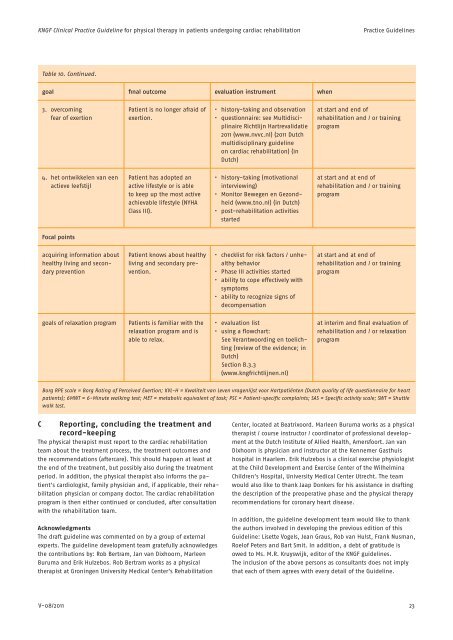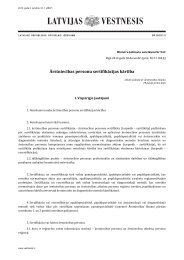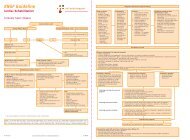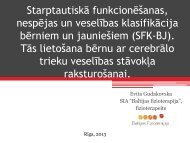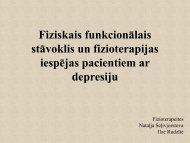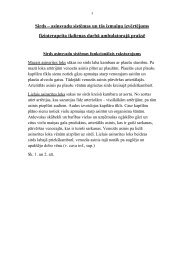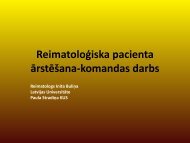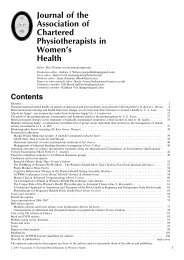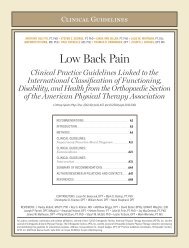KNGF Guideline Cardiac rehabilitation
KNGF Guideline Cardiac rehabilitation
KNGF Guideline Cardiac rehabilitation
You also want an ePaper? Increase the reach of your titles
YUMPU automatically turns print PDFs into web optimized ePapers that Google loves.
<strong>KNGF</strong> Clinical Practice <strong>Guideline</strong> for physical therapy in patients undergoing cardiac <strong>rehabilitation</strong><br />
Practice <strong>Guideline</strong>s<br />
Table 10. Continued.<br />
goal final outcome evaluation instrument when<br />
3. overcoming<br />
fear of exertion<br />
Patient is no longer afraid of<br />
exertion.<br />
• history-taking and observation<br />
• questionnaire: see Multidisciplinaire<br />
Richtlijn Hartrevalidatie<br />
2011 (www.nvvc.nl) (2011 Dutch<br />
multidisciplinary guideline<br />
on cardiac <strong>rehabilitation</strong>) (in<br />
Dutch)<br />
at start and end of<br />
<strong>rehabilitation</strong> and / or training<br />
program<br />
4. het ontwikkelen van een<br />
actieve leefstijl<br />
Patient has adopted an<br />
active lifestyle or is able<br />
to keep up the most active<br />
achievable lifestyle (NYHA<br />
Class III).<br />
• history-taking (motivational<br />
interviewing)<br />
• Monitor Bewegen en Gezondheid<br />
(www.tno.nl) (in Dutch)<br />
• post-<strong>rehabilitation</strong> activities<br />
started<br />
at start and at end of<br />
<strong>rehabilitation</strong> and / or training<br />
program<br />
Focal points<br />
acquiring information about<br />
healthy living and secondary<br />
prevention<br />
Patient knows about healthy<br />
living and secondary prevention.<br />
• checklist for risk factors / unhealthy<br />
behavior<br />
• Phase III activities started<br />
• ability to cope effectively with<br />
symptoms<br />
• ability to recognize signs of<br />
decompensation<br />
at start and at end of<br />
<strong>rehabilitation</strong> and / or training<br />
program<br />
goals of relaxation program<br />
Patients is familiar with the<br />
relaxation program and is<br />
able to relax.<br />
• evaluation list<br />
• using a flowchart:<br />
See Verantwoording en toelichting<br />
(review of the evidence; in<br />
Dutch)<br />
Section B.3.3<br />
(www.kngfrichtlijnen.nl)<br />
at interim and final evaluation of<br />
<strong>rehabilitation</strong> and / or relaxation<br />
program<br />
Borg RPE scale = Borg Rating of Perceived Exertion; KVL-H = Kwaliteit van Leven vragenlijst voor Hartpatiënten (Dutch quality of life questionnaire for heart<br />
patients); 6MWT = 6-Minute walking test; MET = metabolic equivalent of task; PSC = Patient-specific complaints; SAS = Specific activity scale; SWT = Shuttle<br />
walk test.<br />
C Reporting, concluding the treatment and<br />
record-keeping<br />
The physical therapist must report to the cardiac <strong>rehabilitation</strong><br />
team about the treatment process, the treatment outcomes and<br />
the recommendations (aftercare). This should happen at least at<br />
the end of the treatment, but possibly also during the treatment<br />
period. In addition, the physical therapist also informs the patient’s<br />
cardiologist, family physician and, if applicable, their <strong>rehabilitation</strong><br />
physician or company doctor. The cardiac <strong>rehabilitation</strong><br />
program is then either continued or concluded, after consultation<br />
with the <strong>rehabilitation</strong> team.<br />
Acknowledgments<br />
The draft guideline was commented on by a group of external<br />
experts. The guideline development team gratefully acknowledges<br />
the contributions by: Rob Bertram, Jan van Dixhoorn, Marleen<br />
Buruma and Erik Hulzebos. Rob Bertram works as a physical<br />
therapist at Groningen University Medical Center’s Rehabilitation<br />
Center, located at Beatrixoord. Marleen Buruma works as a physical<br />
therapist / course instructor / coordinator of professional development<br />
at the Dutch Institute of Allied Health, Amersfoort. Jan van<br />
Dixhoorn is physician and instructor at the Kennemer Gasthuis<br />
hospital in Haarlem. Erik Hulzebos is a clinical exercise physiologist<br />
at the Child Development and Exercise Center of the Wilhelmina<br />
Children’s Hospital, University Medical Center Utrecht. The team<br />
would also like to thank Jaap Donkers for his assistance in drafting<br />
the description of the preoperative phase and the physical therapy<br />
recommendations for coronary heart disease.<br />
In addition, the guideline development team would like to thank<br />
the authors involved in developing the previous edition of this<br />
<strong>Guideline</strong>: Lisette Vogels, Jean Graus, Rob van Hulst, Frank Nusman,<br />
Roelof Peters and Bart Smit. In addition, a debt of gratitude is<br />
owed to Ms. M.R. Kruyswijk, editor of the <strong>KNGF</strong> guidelines.<br />
The inclusion of the above persons as consultants does not imply<br />
that each of them agrees with every detail of the <strong>Guideline</strong>.<br />
V-08/2011<br />
23


